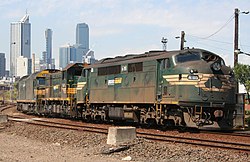Diesel locomotive

A diesel locomotive is a locomotive powered by a diesel engine. The diesel engine drives the locomotive's wheels through a transmission system. Diesel locomotives are very popular worldwide, due to their ease of use and reliability. They can be more powerful than steam locomotives and do not need an expensive power grid like electric locomotives.
In the 1930s they were often used for runs of very short distances. After the middle 20th century they became the most common kind for long runs, too.
Transmission systems
- Mechanical transmission uses a gearbox, shaft or chain (diesel-mechanical).
- Electric transmission works by generating electricity which is in turn used to power the wheels (diesel-electric). This is the kind most used.
- Hydraulic transmission uses a hydraulic transmission system (diesel-hydraulic).
Diesel Locomotive Media
The ČKD ČME3, a common example of a diesel shunting locomotive
The InterCity 125 set a speed record – 148 mph (238 km/h) – for a diesel-powered train in 1987. Capable of 125 mph (201 km/h) in regular service, the train consists of two power cars with either seven or eight carriages between them.
These locomotives operated by Pacific National in Australia show three styles of diesel locomotive body: cab unit (front), hood unit, and flat-nose (rear).
Petrol–electric Weitzer railmotor, first 1903, series 1906
Swiss and German co-production: world's first functional diesel–electric railcar, 1914
The Soviet-designed, German-built E el‑2 diesel–electric, introduced in 1925, remained in service until 1954.
Shunter of Nederlandse Spoorwegen from 1934, in modern livery
Renault VH, France, 1933/34
British Rail Class D16/1, since 1948
Overview of a driver's cab and an engine room of the Hungarian cab-styled M61 diesel–electric locomotive. Changes in diesel engine sounds can be heard as the throttle position is changed.
Soviet 2TE116 diesel–electric locomotive in motion with a freight train. Sounds of diesel engines at full power.










